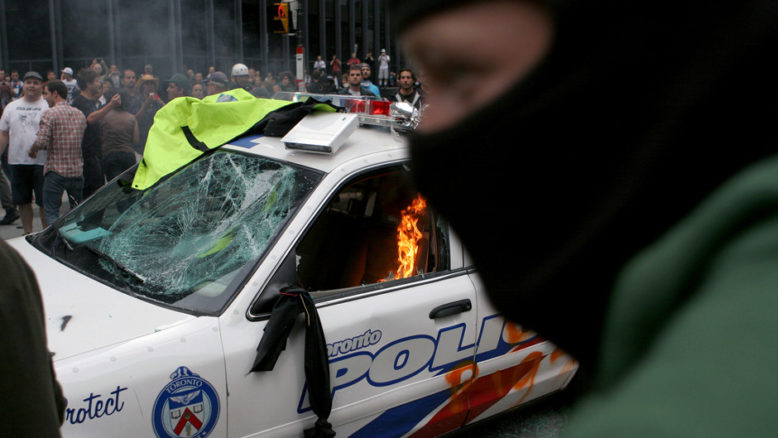Anonymous submission to North Shore Counter-Info. This is a contribution to #MyG20Story
I’m based in Hamilton was involved in Southern Ontario Anarchist Resistance, SOAR, in the leadup to the 2010 G20 summit. In the years since, a lot of our conversations about that organizing experience since focus on repression – the undercovers, the mass arrests, the prison time – but lately what stands out to me most about it is how ambitious the whole mobilization was.
The crowds that came out to the G20 demos were qualitatively different than crowds that come out to large demos in this area at other times, because of the scale and depth of the organizing that went into it. Usually, a big crowd is because a social media post gets a lot of attention due to circumstances that are ultimately ephemeral, or because an established group calls for it, and the rest of us are just left to decide whether or not to participate on the terms they set.
The participants at the G20 were much more organized – into organizations, collectives, affinity groups, and blocs — and the mobilization itself was intensely decentralized, with all those forms of organization coming with their own plans.
Actions during the week of the mobilization were coordinated through the Toronto Community Mobilization Network, TCMN, which worked to share logistics between different organizing crews and also to ensure a separation of place or time between different kinds of tactics, within a context of mutual respect. There’s more to be said about if this was successful, but especially during these latest anti-police demos, seeing how much energy has gone into worrying about what participants might do, the difference in intention seems important.
SOAR plugged into the TCMN framework to organize three actions on the Saturday and Sunday. SOAR too was highly decentralized – we were a loose organization of anarchists from a dozen different cities across southern Ontario, and the expectation was that we were all organized into affinity groups within our cities. This meant it wasn’t needed for every single individual intvestedin the SOAR actions to be in the room each time to have their voice heard – it just required that one person from their affinity group or cluster of affinity groups show up. (There were three affinity groups coordinating with each other among my friends in Hamilton, and only representatives from one regularly attended SOAR meetings.)
SOAR also hosted three large spokescouncil meetings in the leadup to the action. We invited anarchist affinity groups from much further afield to send representatives to get briefed on plans and to take on roles. The third such meeting had representatives from groups totalling 500 people together in the room, actively contributing to firming up logistics. The advantage of having people organized into small 3-5 person self-organized groups is tremendous. I meant that, like the TCMN, we didn’t require everyone to become part of a single whole, to make every little decision in coordination with everyone else. This avoids the kind of unity based on a lowest-common-denominator, which I would say is a false unity. The unity we built around the G20 mobilization was based on autonomy – organizers created a framework and invited others to plug in and take on tasks or pull off actions as they saw fit.
This decentralization meant that the one SOAR action that was able to take place amid the escalating repression, Saturday’s Get Off the Fence march, was essentially an unstoppable force. The police carried out a dozen pre-emptive arrests of SOAR organizers, but the pigs don’t understand decentralization.. Hundreds of people had discussed strategy, consulted maps, knew what roles neneded to be filled, and most importantly had come with their own plan. They weren’t just a passive mass, waiting around for an organizer to tell them what to do – they were self-organized and co-ordinated. (Again, it would be interested to look back at the organizing and consider what worked and what didn’t, but those were the intentions and it seemed to me that they were at least partially successful.)
I haven’t participated in anything of that ambition and scale since, even though lots of other worthwhile campaigns have taken place. The repression following the G20 successfully broke the regional network, and it took years for something similar to reform – the regional network that organizes against pipelines took up many of the principles around diversity of tactics and decentralization from the SOAR organizing.
More than the bruises, the time in jail, the lost friends, I remember that feeling that we could organize on a scale to push back the largest police deployment in Canadian history, as part of an international movement against organizations like the G20, and the world they represent. That the G20 mobilizations produced so many memorable moments of struggle is proof that this is possible. But even more than what happened in the streets, the organizing in the leadup remains a highwater mark for planning to massively retake the city and imagine a world on radically different terms.

